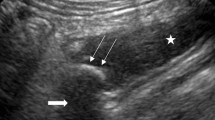Abstract
Intra-abdominal calcification can be classified into four categories based on morphology: concretions, conduit wall calcification, cyst wall calcification, and solid mass calcification; it can also be divided based on anatomic location into four abdominal quadrants. This classification can aid with differential and, at times, the final diagnosis. Concretions are discrete precipitates within a vessel or organ; examples include the gallbladder (gallstones), urinary tract (renal, ureteral or bladder stones), diverticulum/appendix (fecalith, appendicolith), and pelvic veins (phleboliths). Conduit calcification refers to calcification within the walls of a fluid-filled hollow tube such as atherosclerotic plaquing of the abdominal aorta. When the wall of a cyst or hollow organ such as an aneurysm or the gallbladder (porcelain) calcifies, it becomes cyst wall calcification (smooth but curvilinear rim). Solid mass calcification (extensive but variable) includes mesenteric lymph node calcification, calcification of lymph nodes after an infection such as tuberculosis and leiomyoma. Structures like the costal cartilage, mesenteric lymph nodes, pelvic vein clots (phleboliths), and prostate gland may become calcified and still be of no clinical significance. On the contrary, calcification of the pancreas, kidney, blood vessels, gallbladder, uterus, urinary bladder, and appendix is considered pathological. In most circumstances, either diagnostic ultrasound or computed tomography (CT) will establish a definitive diagnosis and offer thorough imaging assessment for abdominal calcifications, with ultrasound being the test of choice for gallstones. A CT can help differentiate between urinary tract calculi (irregular with uniform density) and phlebolith (ovoid with lucent center), because the latter is clinically insignificant but the former is not. Some of the vascular calcification patterns include tram-track for non-aneurysmal, fusiform for aneurysmal, and calcification of tunica media for Monckeberg’s [medial] calcification.
Access provided by Autonomous University of Puebla. Download chapter PDF
Similar content being viewed by others
Keywords
What are the categories of calcification based on morphology? | Concretions, conduit wall calcification, cyst wall calcification, and solid mass calcification |
How can calcification be classified based on anatomy? | Into four abdominal quadrants |
Define concretions with examples. | Discrete precipitates; gallstones, renal, ureteral or bladder stones, fecalith, appendicolith, phlebolith |
Give an example of conduit wall calcification . | Atherosclerotic plaquing of the abdominal aorta |
What are the examples of cyst wall calcification ? | Aneurysmal calcification and porcelain gallbladder |
Describe the usual pattern of solid mass calcification with examples. | Extensive but variable; normal lymph node or after infection such as TB and leiomyoma |
Calcification of which structures is considered clinically insignificant on abdominal imaging? | Costal cartilage, mesenteric lymph nodes, pelvic vein clots (phleboliths), prostate gland |
Name some structures, calcification of which is considered pathological on abdominal imaging? | Pancreas, kidney, blood vessels, gallbladder, uterus, urinary bladder, appendix |
What is the best diagnostic imaging modality in general for assessing abdominal calcifications? | Ultrasound or CT |
What is the imaging modality of choice for suspected gallstones? | Ultrasound |
Which imaging modality can differentiate between phlebolith and renal/ureteric calculi? | CT |
What are the characteristic features used to differentiate between phlebolith and renal/ureteric calculi? | Phleboliths are ovoid with lucent center; renal/ureteric calculi are irregular with uniform density. |
What is Monckeberg’s [medial] calcification ? | Calcification of tunica media of medium-sized muscular vessels |
Describe vascular calcification patterns . | Tram-track for non-aneurysmal; fusiform for aneurysmal |
Further Reading
Bassano JM. Abdominal calcifications and diagnostic imaging decision making: a topic review. J Chiropr Med. 2006;5(1):43–52.
Brant WE, Helms CA, editors. Fundamentals of diagnostic radiology. Philadelphia: Lippincott Williams & Wilkins; 2012.
James B, Kelly B. The abdominal radiograph. Ulster Med J. 2013;82(3):179.
Bickle IC, Kelly B. Abdominal x rays made easy: calcification. Student BMJ. 2002;10:272–4.
Author information
Authors and Affiliations
Corresponding author
Editor information
Editors and Affiliations
Rights and permissions
Copyright information
© 2019 Springer Nature Switzerland AG
About this chapter
Cite this chapter
Siddiqui, E. (2019). Calcifications. In: Eltorai, A., Hyman, C., Healey, T. (eds) Essential Radiology Review. Springer, Cham. https://doi.org/10.1007/978-3-030-26044-6_80
Download citation
DOI: https://doi.org/10.1007/978-3-030-26044-6_80
Published:
Publisher Name: Springer, Cham
Print ISBN: 978-3-030-26043-9
Online ISBN: 978-3-030-26044-6
eBook Packages: MedicineMedicine (R0)




